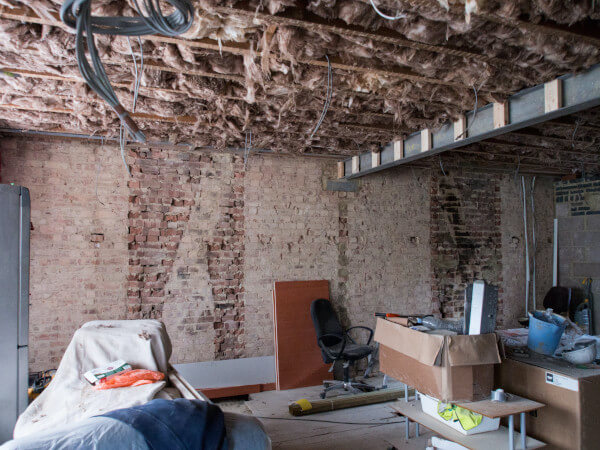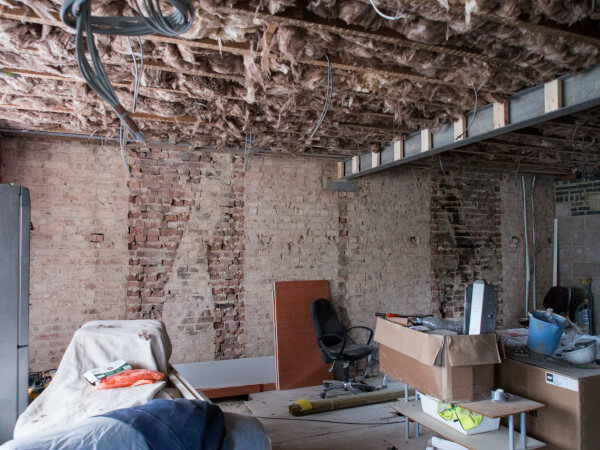A Guide to Laminate Wood Flooring: Pros and Cons

Considering laminate wood flooring for your home? The benefits abound, from costs and style to durability

With lumber prices skyrocketing, many homeowners are rethinking their material choices for renovations. One alternative to hardwood flooring, that deserves a second look, is laminate that looks like wood. Although lumber prices are starting to drop back to normal levels, Sweeten lays out what the benefits are beyond price alone to choosing laminate.
Sweeten matches home renovation projects with vetted general contractors, offering advice, support, and up to $50,000 in renovation financial protection—for free.
What is laminate flooring?
Lamination is a process of uniting layers of material by an adhesive (or other means.) Laminate wood flooring is just that–it is three material layers pressed together, using heat, to create a strong product. The base layer of laminate flooring is wood particleboard, followed by a layer with a wood image, known as the design layer. Over top is a protective transparent wear layer.
It is easy to confuse laminate wood flooring with vinyl wood flooring. The main difference is their composition: laminate is 99% wood product, and vinyl wood flooring is all plastic.
Pros and cons of laminate wood flooring
As with everything, there are tradeoffs when choosing one material over another. However, laminate flooring has a lot going for it.
Pros:
Less expensive than hardwoods
Durable: kid- and pet-friendly
Comes in many styles and color options
Is easy to install as a DIY project
Can last from 10 to 25 years, depending on quality, care, and amount of use
Generally eco-friendly: Made of post-consumer wood products; no need for glues or adhesives in installation; can be removed and re-used; can be recycled
Cons:
Unlike solid hardwood flooring, laminate can’t be refinished when it begins to show signs of wear
It’s not 100% waterproof (not recommended for kitchens, bathrooms, or over cement slabs, as in basements)
Difficult to repair
Features of laminate wood flooring
Laminate wood flooring has been around for more than 40 years. Over that time, manufacturers have improved on both the product’s performance and style. Today, there seem to be endless variations of the types of laminate available. Here are some of the features to keep in mind when choosing the right kind of laminate floors for your renovation.
Style and design
Because laminate flooring is manufactured, the sky’s the limit on styles. With advances in technology, laminate wood flooring can very closely imitate the look and feel of real hardwoods. Today’s laminate includes grooves and ridges in the texture that create a natural-looking character. Boards come in all sizes: short, long, thin, or wide-plank. Want that hand-scraped wood look? No problem. Working on a coastal look? Laminate comes in gray and white-washed stains. You can choose your look by color variation, wood species, style theme, and size.
Underlayment
Laminate wood flooring is installed as a floating floor. As a part of proper installation, a separate underlayment is required. The type of underlayment varies depending on the subfloor. However, some laminate wood flooring products come with attached underlayment. In this case, a separate underlayment is not necessary. Pay attention when you buy as to whether or not your planks already come with or without this feature.
Waterproof
No laminate wood flooring is truly waterproof; for that, look to vinyl wood flooring. Despite this, you will see laminate wood flooring on the market, advertised as being waterproof. This tends to mean it is “spillproof.” Read the warranty closely. In the case where water gets under the flooring, either due to standing water under an appliance or installation over a pervious cement slab, the wood material can still be damaged.
Noise resistance
Some laminate manufacturers market features to reduce sound transmission underfoot. This can include attached backings, or the option to pair the flooring with a specific additional underlayment pad.
Use with radiant floor heating
Radiant heating is a type of in-floor heating system that goes below the floor covering. Just as some solid wood species are better than others for use with radiant heating, the same goes for laminate. There are laminate wood flooring products designed for use with radiant heating. Discuss with your contractor what humidity levels you need to maintain to avoid gapping between the boards.
Durability rating
Laminate wood flooring is known for being durable. Just how durable? Check its AC rating. Short for Abrasion Criteria, the rating ranges from 1 to 5, with 5 being the most durable. AC1 is suitable for low-traffic areas. For residential uses, AC3 or AC4 is generally advised for high traffic rooms.
Laminate wood flooring cost vs. hardwood
Obviously, solid hardwood flooring comes from planks milled from real trees. And that explains why, generally speaking, solid hardwood floors cost more than laminate flooring. The price is tied to factors such as weather, the rareness of wood, and export costs. Conversely, laminate wood flooring costs are based on its quality and style features: thickness; durability of wear layer; and presence of underlayment.
While laminate overall is less expensive than hardwoods, high-end laminate wood may cost more per square foot than low-end hardwoods. When choosing your laminate flooring, think about your durability needs, in addition to the other features we covered. (And, keep in mind, there are other variables to consider overall when choosing a flooring material!)
How much does hardwood flooring cost?
According to Forbes, hardwood flooring costs can average from $3–$12 a square foot. Add to that $26 (or higher) for 500 square feet of the required underlayment. Labor costs for hardwood flooring installation add an extra $3–$9 a square foot.
The type of wood you choose affects the cost. For example, an exotic hardwood, like Brazilian walnut, can range from $8–$14 a square foot. A softer, more plentiful wood, such as pine, averages from $3–$6 a square foot.
Adding together materials and labor averages, total hardwood flooring costs can range between $6–$21 a square foot. For perspective, costs to install real hardwood flooring in a 500 square foot area would be between $3,000–$10,500.
How much does laminate flooring cost?
Most laminate flooring comes with an interlocking tongue-and-groove system. Being a very DIY-friendly option, it’s helpful to focus on material costs alone. Laminate flooring can be purchased for as low as $0.59 a square foot, and can and range upwards of $6 a square foot. Purchasing laminate with an attached underlayment will cost you more up-front, but will save on labor later.
Breaking this down further, thin laminate with a thin wear layer is available for as low as under $1 a square foot. Medium quality laminate ranges from $2–$4, and high-quality sells for $3–$5+ a square foot.
How much does it cost to install laminate wood flooring?
If you’d rather have a pro install your laminate wood flooring, labor costs average between $1–$3 a square foot.
Altogether with materials and labor combined, laminate floors can cost as low as $1.59 and as high as $9 a square foot. That means it would cost between $795 and $4,500 to install laminate wood flooring in a 500 square foot area.
Choosing laminate floors for your home
The advances in laminate flooring technology over the past several decades have made a once-eschewed flooring material a strong contender to hardwoods. With its lower cost, durability, eco-friendliness, and wide range of style options, more people today are happily picking laminate hardwood flooring for their homes.
—
Sweeten handpicks the best general contractors to match each project’s location, budget, scope, and style. Follow the blog, Sweeten Stories, for renovation ideas and inspiration and when you’re ready to renovate, start your renovation with Sweeten
The post A Guide to Laminate Wood Flooring: Pros and Cons appeared first on Sweeten.
Did you miss our previous article…
https://www.tampa-bay-homes-guide.com/?p=828
